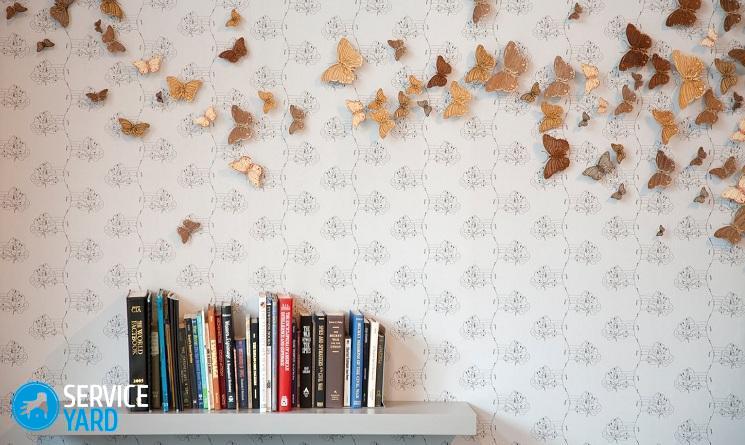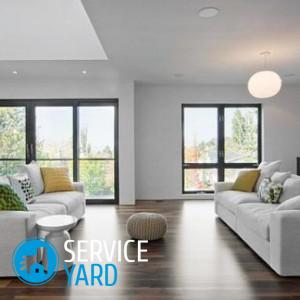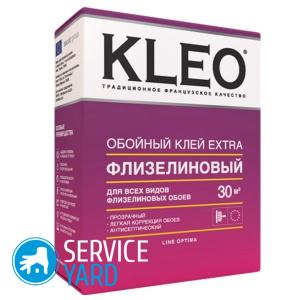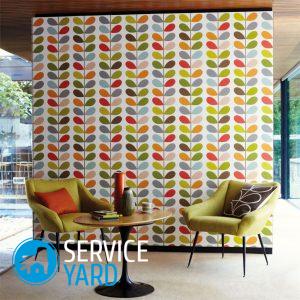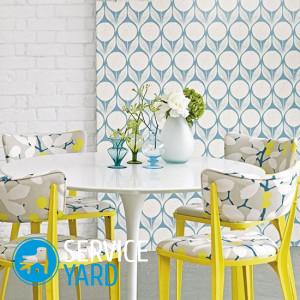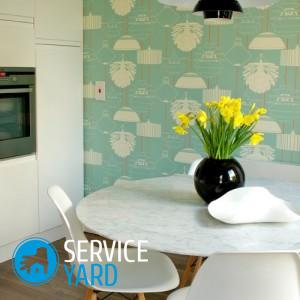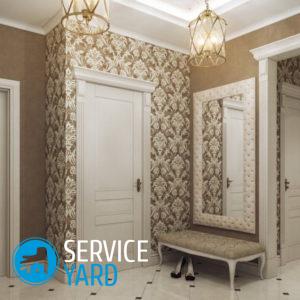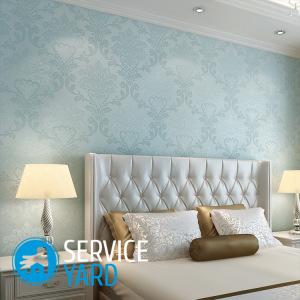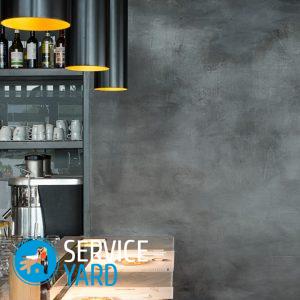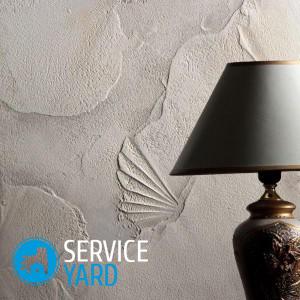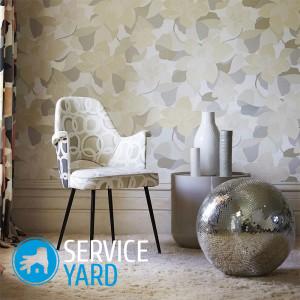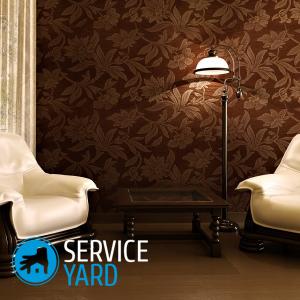Is it possible to glue wallpaper on water-based paint on the wall?

The owner of an apartment often has a desire to radically change the interior. There can be many reasons for this, but in a hardware store there is always something to replace a whitewash or old tile. But sometimes the beginner finisher is stopped by the need to somehow decide the fate of the old coating. Is it mandatory to shoot it? Not always. We can talk about whether it is possible to glue wallpaper on water-based paint on the wall.
to contents ↑Is there really an emulsion?
The answer to the question, it is possible to glue wallpaper on a water-based paint, it can turn out to be positive if the surface is quite smooth and has no noticeable flaws. But before starting work, it is very important to determine: are there really a water emulsion on your walls?
Wallpaper is definitely not worth gluing onto oil or acrylic paint, they adhere very poorly to plaster or putty, while water-based paint holds them well. Therefore, it makes sense to conduct a simple study. For it, you need some sharp object with which you can pry off the paint - a spatula or knife:
- Carefully peel off a small piece of the coating.
- Consider what has fallen off the wall.
to contents ↑Important! Water-based paint is separated from the wall with little effort and in small pieces, or even just crumbles, and more often - together with plaster. To process the walls, oil or nitro paints are often used. So they fall off the wall in large pieces or even whole layers.
Will the wallpaper hold?
If you came to the conclusion that you have a water emulsion on the walls, you can safely glue the wallpaper. True, not all of them will be equally well held, so it makes sense to conduct another experiment. To do this, you will need:
- a piece of wallpaper;
- wallpaper glue.
A piece of wallpaper can be taken from the same roll that you bought to decorate the room. You need quite a bit - even a cropped edge is enough for you, but it is better to take a square 10x10 cm:
- Spread some glue.
- Stick a piece on the wall.
- See if he will hold on.
to contents ↑Important! Water-dispersion paint has the same properties as water-based paint, so you can also glue wallpaper on it.
Choose a wallpaper
Before you glue wallpaper on water-based paint, you need to decide what exactly you want to see on the walls of your apartment. It is better to refuse thin paper wallpapers right away, as well as not very high-quality vinyl ones.
You should be interested in wallpapers:
- non-woven;
- non-woven vinyl;
- tissue;
- liquid.
Important! Keeping track of all the fashion trends in the field of decorating is very difficult, especially if you do not do this every day on a professional basis. Therefore, in order not to get lost in the store, we suggest you study the main design solutions:
Is it possible to glue non-woven wallpaper on a water-based paint?
This material dries amazingly quickly, so it is just perfect for pasting over water-based paint. Why is it recommended to use non-woven fabrics? They have a wonderful property - they absorb almost all the glue before it penetrates the paint. That is, the water-emulsion layer simply does not have time to fall off.
Important! And so that wallpapering does not turn into a feat akin to Stakhanovsky, first check out our repair workshops:
the cloth
Non-woven fabric wallpaper is also a very good option. They look rich, while they differ in the same qualities as just non-woven. Other double-layer webs are also suitable. But the paper base is not suitable, because it dries slowly, as a result - the paint dissolves and leaves.
Liquid
In fact, this is not really a wallpaper. You do not need to glue them. They perfectly connect to any surface. If the wall is not perfect, such wallpapers are best suited. Their composition is such that they harden faster than they penetrate the paint layer and begin to dissolve it.
to contents ↑Important! Another advantage of them is that you can even finish an uneven surface, so you definitely will not have much trouble with the wall.
Is it mandatory to glue on the paint?
Aqueous emulsion paint, as a rule, has high adhesion - that is, it provides reliable adhesion with putty or plaster, or with wallpaper. But this does not mean that it must be preserved. Nothing prevents the removal of this layer before proceeding with gluing.
A water emulsion has its own characteristics, which must be taken into account before proceeding with gluing:
- The surface may peel off.
- The paint is easy to crack.
to contents ↑Important! If the surface is not pre-treated, the wallpaper will fall unevenly, and in addition, they can crack and even tear.
Remove paint
If there are too many cracks and delaminations on the wall, it is best to remove the layer of the emulsion to the base. This is a rather dirty business, but not particularly difficult. You will need:
- a basin or bucket;
- hot water;
- old hard terry towel.
Have prepared everything you need - start washing. A terry towel is an ideal rag, but in principle, you can use something else:
- any hard rags;
- rubber brush.
The process itself is extremely simple. The surface must be thoroughly wetted and then washed off with a rag. Only it is advisable to change the water as often as possible, and the rag - as it should be washed.
to contents ↑Important! And what if the plaster began to fall off? After the wall dries, it’s good to close the cracks.
We process the wall
Deciding to leave a coat of paint, carefully inspect the wall. It should not be:
- cracks;
- noticeable bulges;
- chips and delaminations;
- accumulations of dirt.
Important! If you are lucky and there is no paint on your wall under the wallpaper, it’s too early to rejoice, because cracked plaster can cause a lot of trouble, and therefore plaster cracks - the primary task.
to contents ↑Grind the wall
If you see any of the above, you will have to arm yourself with a piece of sandpaper with large grain and put everything in order. Remove any irregularities, and then remove dirt and dust. Moreover, this should be done even when the wall looks perfect. If there are no noticeable flaws on it, this does not mean that the paint is firmly held everywhere.
to contents ↑Important! Sanding marks are best removed with a vacuum cleaner, not with a broom or cloth.
Primer
No matter how hard you polish, it’s still difficult to ensure that not a single centimeter of the surface remains unprocessed. There are always gaps. This means that there may be places where the paint does not hold well. Is there a way out? Of course.
If the question is whether it is possible to glue wallpaper on water-based paint, you gave a positive answer, the next step will be choice of primer for walls for wallpaper.
It is not worth neglecting the soil, even if you are going to glue thick wallpapers - two-layer vinyl, non-woven or fabric:
- The fabric, of course, conceals a lot, but still, with poor-quality processing of the walls, bubbles will appear or the wallpaper will begin to fall off with the paint.
- There is one more consideration. Mold under the wallpaper is a fairly common thing if the technology is broken. But the soil with an antifungal composition will not allow her to settle. Need deep penetration primer for mineralized surfaces. It is better to choose a deep penetration soil with an antiseptic effect.
to contents ↑Important! Before applying the primer, the wall must be thoroughly dried.
Glue heavy wallpaper
If you have chosen fabric wallpaper, get ready for the fact that you have to tinker with the wall. Such a coating in itself is quite heavy, so the wall should be as even as possible, in addition, provide good adhesion. There is nothing to be done, you have to look for a way out.
There are only two of them:
- plaster;
- stick a layer of facing paper.
In both cases, you will need to check how smooth the surface will turn out. There is a construction rule for this. Its length in this case can vary from half a meter to one and a half meters.
to contents ↑Important! If you chose the option with facing paper, keep in mind that its seams should not coincide with the joints of the wallpaper. To avoid coincidences, it is better to start facing the adhesive layer with half the width.
Two words about oil paint
Despite the fact that this situation can be regarded as critical, it arises quite often. Previously, the walls were covered with oil paint mainly in non-residential premises:
- the kitchen;
- a bathtub;
- the toilet;
- common corridor.
to contents ↑Important! To remove oil paint is a thankless task. Rubbing the wall with a solvent is unpleasant and will not bring much result. If there is at least the slightest opportunity, separate the paint with strips, and then clean, sand and plaster the wall in the same way as in the case of a water emulsion.
Glue wallpaper
So, everything is ready for you - the wall is in order, the wallpaper is bought, as well as the glue. The point is small - to make the finish.
Important! If you do not want to be distracted, cut the wallpaper immediately. The standard option is panels, the length of which is equal to the height of the wall with vertical pasting, and the length of the wall - with horizontal. Plus a few centimeters of stock. The allowance will disappear during shrinkage. If he does not go anywhere, then he can then be cut off or driven into the baseboard.
Sometimes you need to customize the picture. Gluing wallpaper is always better with an assistant, or even three or four:
- Carefully read the instructions for wallpaper and glue - in some cases, the wall is not spread on the sheet with glue.
- Make markings on the building level - the strips should be either strictly vertical or strictly horizontal.
- Spread the wallpaper on the floor (which you first need to sweep, or even wash).
- Apply glue.
- Put a sheet of wallpaper on the wall.
- Smooth the sheet with a spatula, remove all air bubbles.
to contents ↑Important! If you have taped a room, and after a while decided to change its color, what should I do? Glue again, or can you just paint?
Stock footage







Thus, wallpapering the surface on which water-based paint was previously - is a very real thing. As in any other case, it is important to follow the procedure and prepare the wall correctly.
- Acrylic paint for walls
- Wallpaper glue
- Liquid wallpaper design combinations and interesting ideas
- Is it possible to paint vinyl wallpapers?
- Kitchen Wallpaper Design
- Wallpaper for the living room - design
- Wallpaper in the hallway - design
- Wallpaper design for two types of wallpaper in the bedroom
- Plaster cracks sealing
- What is the best primer for wallpaper walls?
- How to glue non-woven meter wallpaper?
- How to glue vinyl wallpaper on a non-woven base meter in the corners?


